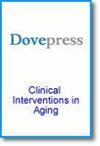Multidimensional-Based Prediction of Pressure Ulcers Development and Severity in Hospitalized Frail Oldest Old: A Retrospective Study
IF 3.7
3区 医学
引用次数: 0
Abstract
Purpose: In recent times, growing uncertainty has emerged regarding the effectiveness of standard pressure ulcer (PU) risk assessment tools, which are suspected to be no better than clinical judgment, especially in the frail and comorbid elderly population. This study aimed to identify the primary clinical predictive variables for PU development and severity in hospitalized older adults, utilizing a multidimensional frailty assessment, and compare them with the Braden scale.Patients and methods: The population consisted of 316 patients, admitted to the Geriatric Unit and Transitional Care of San Bartolomeo Hospital in Sarzana (Italy) during the period 21/02/22-01/07/22. The collected information included both anamnestic and laboratory data. A comprehensive geriatric assessment was performed, including also anthropometric and physical performance measurements. Multivariate logistic analysis was used, both in a binary classification test and in the subsequent ordinal classification test of severity levels. The final performance of the model was assessed by ROC curve estimation and AUC comparison with the Braden scale.
Results: Within the population, 152 subjects (48%) developed PU at different levels of severity. The results showed that age, Braden scale (subscales of mobility and friction/shear), Barthel scale, Mini Nutritional Assessment, hemoglobin, and albumin are predictors associated with the development of PU (AUC 85%). The result is an improvement over the use of the Braden scale alone (AUC 75%). Regarding the identification of predictive factors for PU severity, 4AT also emerges as potentially relevant.
Conclusion: Assessing the subject’s nutritional status, physical performance, and functional autonomies enables the effective integration of the Braden scale in identifying patients most susceptible to developing PU. Our findings support the integration of a comprehensive set of methodologically robust frailty determinants into traditional risk assessment tools. This integration reflects the mutual interplay between patients’ frailty, skin frailty, and PU development in very old hospitalized patients.
Keywords: chronic wounds, nutrition, pressure injury, health analytics, precision medicine, chronic diseases
基于多维度的住院高龄体弱老人压疮发展和严重程度预测:一项回顾性研究
目的:近来,标准压疮(PU)风险评估工具的有效性出现了越来越多的不确定性,人们怀疑这些工具并不比临床判断更好,尤其是在体弱多病的老年人群中。本研究旨在利用多维度虚弱程度评估,确定住院老年人压疮发生和严重程度的主要临床预测变量,并将其与布莱登量表进行比较:研究对象包括意大利萨尔扎纳圣巴托洛梅奥医院老年病科和过渡护理部在2002年2月21日至7月22日期间收治的316名患者。所收集的信息包括病理和实验室数据。此外,还进行了全面的老年病学评估,包括人体测量和体能测量。在二元分类测试和随后的严重程度序数分类测试中都使用了多变量逻辑分析。通过 ROC 曲线估算以及与布莱登量表的 AUC 比较,对模型的最终性能进行了评估:在研究人群中,152 名受试者(48%)出现了不同严重程度的 PU。结果显示,年龄、布莱登量表(移动性和摩擦/剪切力分量表)、巴特尔量表、迷你营养评估、血红蛋白和白蛋白是与 PU 发生相关的预测因子(AUC 85%)。这一结果比单独使用布莱登量表(AUC 75%)有所改进。在确定 PU 严重程度的预测因素方面,4AT 也具有潜在的相关性:结论:评估受试者的营养状况、体能表现和功能自主性可有效整合布莱登量表,以识别最易患 PU 的患者。我们的研究结果支持将一整套方法可靠的虚弱决定因素整合到传统的风险评估工具中。这种整合反映了高龄住院病人的虚弱、皮肤虚弱和PU发展之间的相互影响。 关键词:慢性伤口、营养、压力性损伤、健康分析、精准医学、慢性疾病
本文章由计算机程序翻译,如有差异,请以英文原文为准。
求助全文
约1分钟内获得全文
求助全文
来源期刊

Clinical Interventions in Aging
GERIATRICS & GERONTOLOGY-
CiteScore
6.20
自引率
2.80%
发文量
193
期刊介绍:
Clinical Interventions in Aging, is an online, peer reviewed, open access journal focusing on concise rapid reporting of original research and reviews in aging. Special attention will be given to papers reporting on actual or potential clinical applications leading to improved prevention or treatment of disease or a greater understanding of pathological processes that result from maladaptive changes in the body associated with aging. This journal is directed at a wide array of scientists, engineers, pharmacists, pharmacologists and clinical specialists wishing to maintain an up to date knowledge of this exciting and emerging field.
 求助内容:
求助内容: 应助结果提醒方式:
应助结果提醒方式:


